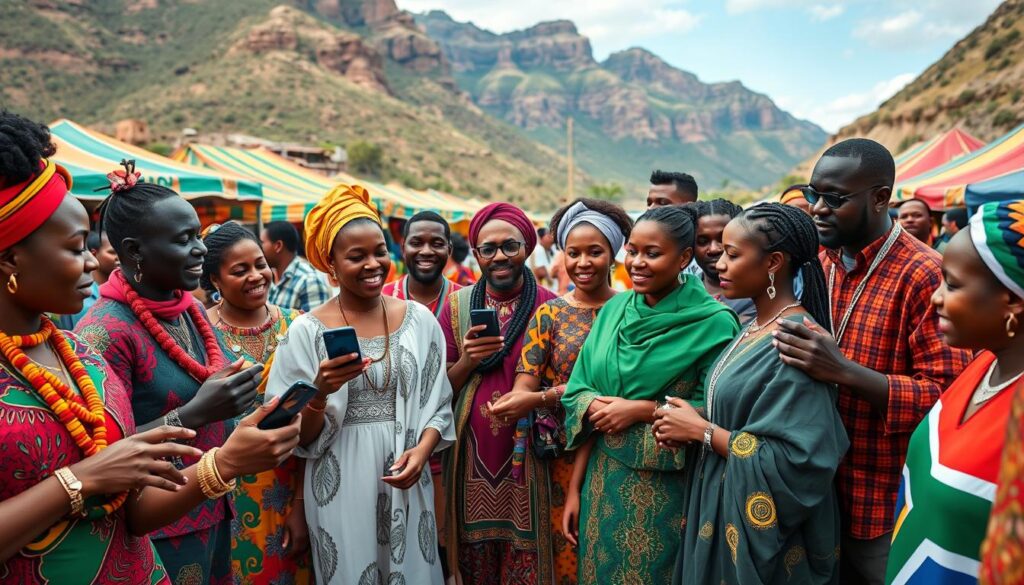I’ve always been amazed by social media influencers and their power to engage audiences. In South Africa, the influencer marketing scene is booming. It’s expected to grow to $22.2 billion globally by 2025. This growth has attracted many brands, with 60% of South African companies now using influencer marketing.
They plan to spend more in 2024. This is an exciting time for brands, with both chances and challenges. They must keep up with influencer partnerships and how to engage with consumers.
In this article, we’ll explore influencer marketing in South Africa. We’ll look at trends, strategies, and best practices. You’ll learn how to succeed in this fast-paced market. Whether you’re experienced in marketing or new to it, this guide will help you make the most of influencer marketing in South Africa.
Key Takeaways
- The global influencer marketing industry is projected to reach $22.2 billion by 2025, indicating significant growth opportunities in South Africa.
- 60% of South African brands currently investing in influencer marketing plan to increase their spending in 2024, showcasing a strong commitment to this marketing strategy.
- 85% of survey respondents find influencer marketing effective, a considerable rise from previous years, indicating a growing confidence in this form of marketing.
- TikTok is the most preferred platform for influencer marketing in South Africa, with 69% of brands choosing it over other social media platforms.
- Smaller influencers, such as nano-influencers (1k-10k followers) and micro-influencers (10k-100k followers), are gaining traction due to their higher engagement rates.
Understanding the Rise of Influencer Marketing in South Africa
In South Africa, the influencer marketing industry is booming. It’s expected to see an 11.6% annual increase in spending. This growth is mainly because people trust influencers more than traditional media. Now, influencers cover a wide range of topics, from mental health to politics.
Current Market Size and Growth Projections
Studies show that 85% of South Africans think influencer marketing works well for brands. Also, 60% of companies plan to spend more on influencer marketing in 2024. This shows how big of a role content creators play in digital marketing.
Impact on Digital Marketing Landscape
Influencer marketing has changed how brands market online in South Africa. Influencers are now key in promoting products and services. They help brands seem more credible and relevant. By using popular social media trends, brands can reach more people in South Africa.
Key Industry Statistics
- The Social Media Code of Conduct published by the Advertising Regulatory Board (“ARB”) governs influencer marketing practices in South Africa.
- The Consumer Protection Act 68 of 2008 as amended (“CPA”) regulates advertising to prevent deceptive, false, or misleading content.
- Influencers are mandated to disclose their partnerships with brands and label sponsored content clearly as per industry standards.
- The Protection of Personal Information Act 4 of 2013 (“POPIA”) mandates influencers to obtain proper consent for data collection and ensure secure data handling.
As influencer marketing in South Africa keeps growing, it’s key for brands and influencers to understand the law. They must build partnerships that are both successful and follow the rules, benefiting consumers.
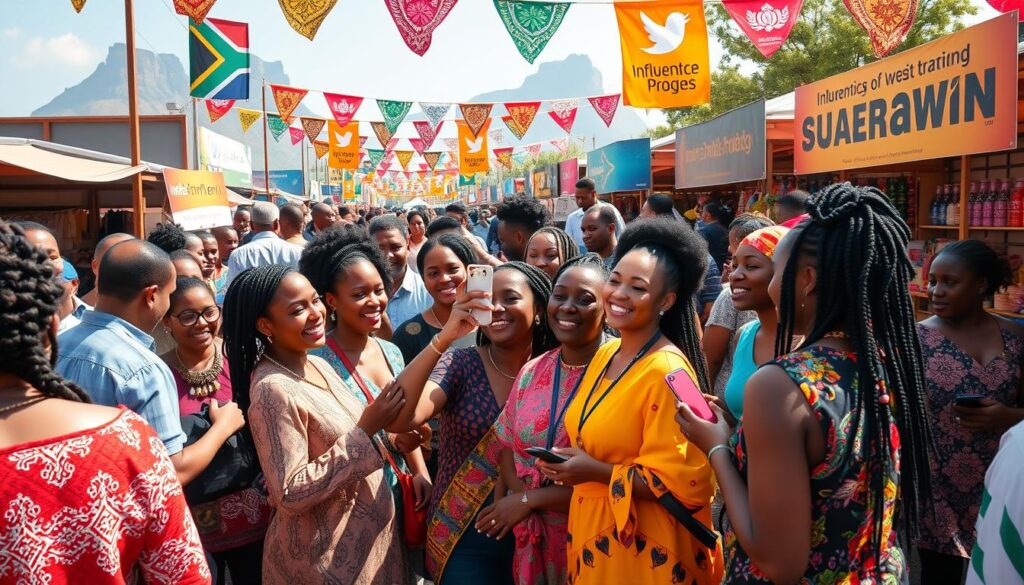
The Evolution of Social Media Influence in South African Markets
South African consumers love online trends, just like people in the US and Europe. This has led to the rise of local influencers in fashion, health, and fitness. Names like Trevor Stuurman, Nadia Jafta, and Caralishious have become big names. They share real and engaging content with their followers.
The digital scene in South Africa is booming. With 45.34 million internet users and 26 million active on social media, it’s a great place for influencers. People spend 9 hours and 38 minutes online daily, a lot of it on social media.
The growth of social media influence in South Africa is part of a bigger trend in Africa. Internet use has jumped by 20% from 2017 to 2018. This change has helped local influencers build strong bonds with their followers. It’s moved from just celebrity endorsements to more focused, culturally relevant messages.
“Influencer marketing has become a powerful tool for brands to enhance their credibility and reach within their target audiences, often at a fraction of the cost of traditional media campaigns.”
As local influencers’ influence grows, brands are getting better at using them. They’re learning how to pick the right influencers and measure how well their campaigns work. This new world of social media influence in South Africa is full of chances for brands to connect with people in meaningful ways.
Top Platforms Driving Influencer Success
In South Africa, some social media platforms stand out more than others. TikTok leads with 69% of brands using it for influencer marketing. Instagram is close with 47%, while YouTube and Facebook have 33% and 28%, respectively.
TikTok’s Dominance in the Market
TikTok quickly became popular in South Africa. It’s known for its short, engaging videos. This format draws in both influencers and brands looking to connect with their audience in new ways.
Instagram and Facebook Performance
Instagram is still important, especially for beauty, fashion, and fitness. It’s great for visual stories and has many content types. Facebook is slower to catch on for influencer marketing but is still useful for some niches and building brands.
YouTube’s Role in Long-form Content
YouTube is key for long, detailed content. Influencers use it to share their knowledge and connect deeply with viewers. It’s good for brands wanting to be seen as leaders and build trust.
The mix of these platforms shows the complexity of influencer marketing in South Africa. Brands need to think about their goals, who they want to reach, and what each platform offers. This helps them work with influencers effectively and connect with their audience.
| Platform | Influencer Usage Percentage |
|---|---|
| TikTok | 69% |
| 47% | |
| YouTube | 33% |
| 28% |

“The rise of influencers turning into founders showcases a shift to organic social media growth to bypass high customer acquisition costs.”
Types of Influencers in the South African Landscape
The South African influencer marketing scene is changing. Now, more focus is on micro-influencers and nano-influencers. These smaller influencers are key for brands wanting real connections with their audience.
Recent stats show that nano-influencers (1,000 to 10,000 followers) are chosen by 44% of brands. Micro-influencers (10,000 to 100,000 followers) are picked by 26% of brands. They’re loved for their high engagement and real connections with followers.
| Influencer Type | Follower Range | Brand Preference | Engagement Rate |
|---|---|---|---|
| Nano-influencers | 1,000 – 10,000 | 44% | Higher |
| Micro-influencers | 10,000 – 100,000 | 26% | Higher |
| Macro-influencers | 100,000 – 1,000,000 | 20% | Medium |
| Mega-influencers | Over 1,000,000 | 10% | Lower |
Even though big-name influencers charge a lot, South African brands are seeing the worth of micro-influencers and nano-influencers. They can really connect with their audience.
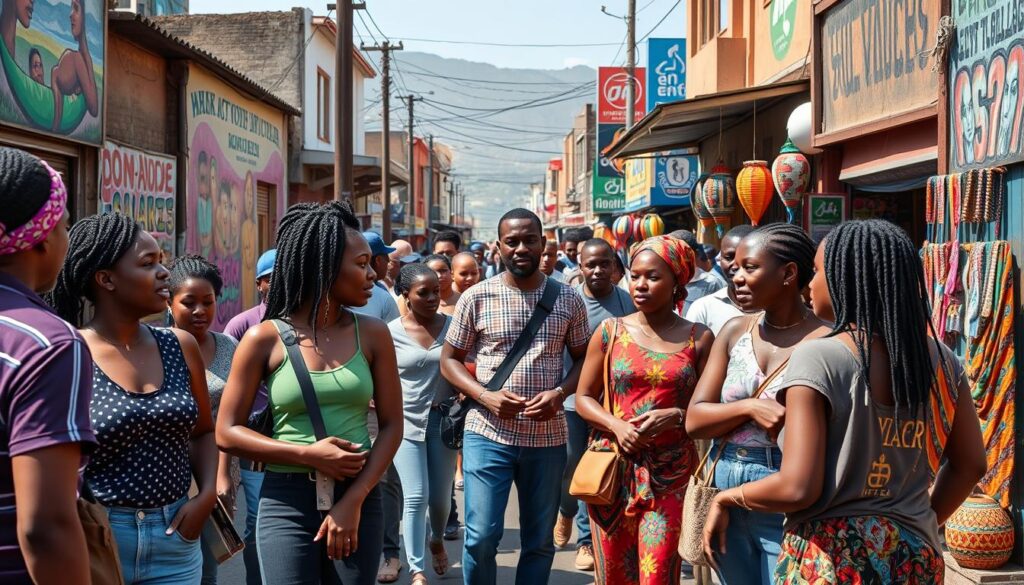
“Nano-influencers, with 1K-5K followers, exhibit strong audience engagement and are a cost-effective option for brands in South Africa.”
Brand Collaboration Strategies and Best Practices
Successful influencer marketing in South Africa needs clear communication and teamwork between brands and influencers. It can be tricky, like when plans aren’t clear or teams don’t work together well. But, by planning carefully, brands can make the most of these partnerships.
Creating Effective Partnership Agreements
It’s key to make clear, fair partnership agreements with influencers. You should talk about what’s expected, who does what, and how you’ll be paid. Being open from the start helps everyone know what they’re working towards.
Setting Campaign Objectives
Good influencer marketing starts with clear goals. These goals can be to get more people to know about your brand or to sell more. By setting goals and tracking them, brands can see what works and improve their plans.
Measuring Success Metrics
It’s important to check how well influencer partnerships are doing. Look at things like how many people saw your content, how many interacted with it, and how many bought something. This helps brands know what’s working and what needs to change.
| Metric | Description | Importance |
|---|---|---|
| Reach | The total number of unique users exposed to the content | Indicates the campaign’s ability to raise brand awareness |
| Impressions | The total number of times the content was viewed | Reflects the overall visibility and exposure of the campaign |
| Engagement Rate | The percentage of followers who interacted with the content | Measures the level of audience interest and interaction |
| Conversion Rate | The percentage of users who took a desired action, such as making a purchase | Evaluates the campaign’s ability to drive tangible business outcomes |
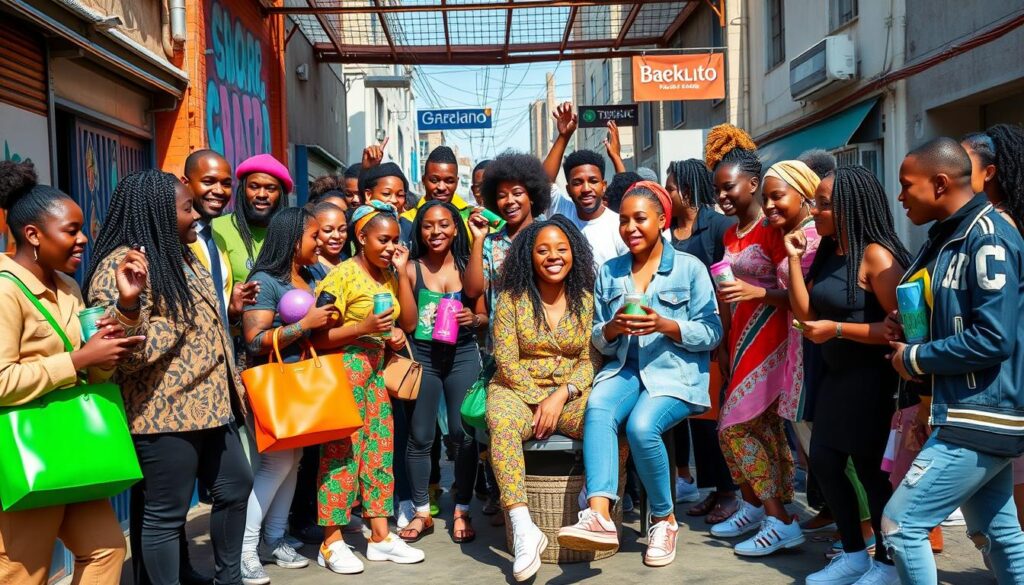
By using these important metrics, brands can learn a lot about their influencer marketing. This helps them make better plans for the future.
Pricing and Budget Considerations for Campaigns
Social media’s influence is growing in South Africa. Businesses see the value of influencer marketing budgets in their strategies. Almost a quarter of brands plan to spend over 40% of their marketing budget on influencer campaigns.
Influencer prices in South Africa vary a lot. Regular influencers charge between R500 and R10,000 for an Instagram post. Celebrity influencers with big followings can charge much more. Brands are moving towards longer campaigns to build a strong brand and increase sales.
| Influencer Tier | Average Rate per Instagram Post |
|---|---|
| Micro-influencers (1K-10K followers) | R500 – R2,000 |
| Mid-tier influencers (10K-100K followers) | R2,000 – R5,000 |
| Macro-influencers (100K-1M followers) | R5,000 – R10,000 |
| Celebrity influencers (1M+ followers) | R10,000+ |
Brands also need to budget for campaign management. This includes a 20% fee on top of the influencer’s rates. It covers the time and effort to find, negotiate with, and manage influencers.
Despite the costs, influencer marketing offers great ROI for brands in South Africa. Studies show it can bring up to 11 times the ROI of traditional digital marketing. This makes it a key tool for growing businesses and increasing sales.
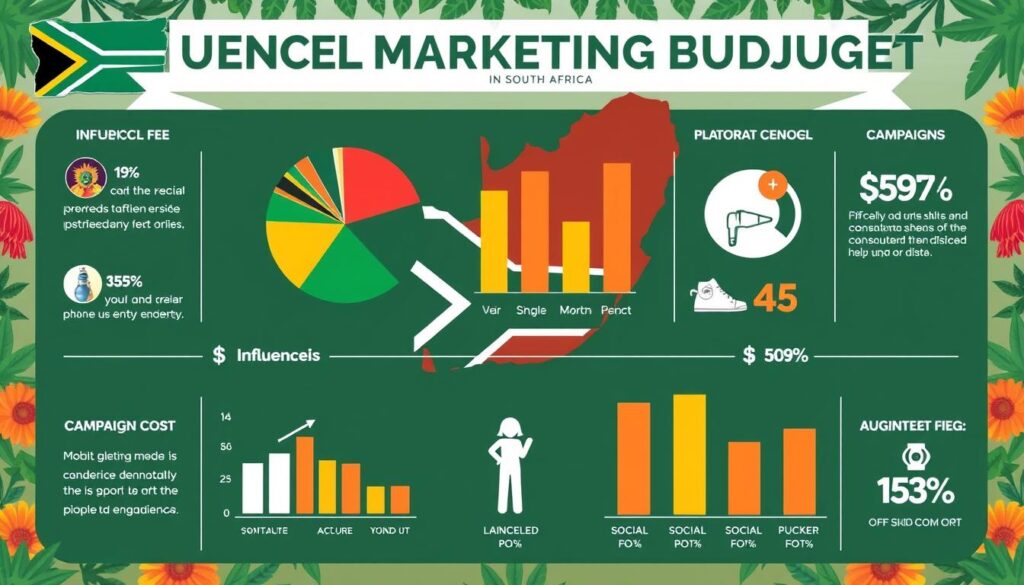
The Role of Micro and Nano Influencers
In South Africa, micro-influencers and nano-influencers are becoming more important. They have a small, focused audience. This makes them great at engaging people and building trust.
Engagement Rates and Audience Trust
Micro-influencers have 5,000 to 50,000 followers. Nano-influencers have 1,000 to 5,000 followers. They get more engagement than big influencers. This means more likes, comments, and shares.
They also make content that feels real and true. This is what South African people want. They want brands that share their values and lifestyle.
Cost-effectiveness for Brands
Working with micro and nano-influencers saves money. They charge less, so brands can spend their money better. In fact, 44% of brands in South Africa choose nano-influencers, and 26% choose micro-influencers. They get a good return on investment.
Brands can reach specific markets and build trust with these influencers. They can also keep their marketing costs low. This is a smart way to engage with people.
| Influencer Type | Follower Range | Engagement Rates | Cost per Post |
|---|---|---|---|
| Nano-influencers | 1,000 – 5,000 | 3 – 10% | R1,000 – R5,000 |
| Micro-influencers | 5,000 – 50,000 | 2 – 6% | R5,000 – R15,000 |
| Macro-influencers | 50,000+ | 1 – 3% | R15,000+ |
The use of micro and nano-influencers is becoming key in South Africa. It’s a smart way for brands to connect with people in a real and affordable way.
Challenges and Solutions in South African Influencer Marketing
The world of influencer marketing in South Africa is changing fast. Brands face many challenges, like finding the right influencers. They often pick the same influencers, even if they don’t fit the brand well. This makes it hard to find the perfect influencer.
Specialized agencies like 6Degrees, Have You Heard Marketing, The SALT, and R-Squared Agency are helping. They focus on influencer identification and managing campaigns. These agencies help brands pick the right influencers for their audience and brand image.
Measuring the success of influencer marketing is another big challenge. Social media platforms like TikTok, Instagram, and Facebook are popular for partnerships. But, tracking the success of these campaigns is key. Agencies and brands use data to see how well campaigns are doing.
| Metric | Average Increase |
|---|---|
| Brand Credibility and Engagement | 30% |
| Brand Loyalty and Influencer Effectiveness | 40% |
| Sales Conversion Rates | 35% |
Quality is becoming more important in influencer marketing in South Africa. Brands that focus on real, long-term partnerships see big gains. They get more trust, engagement, and loyalty from their audience.
“Influencer endorsements that come across as authentic rather than overt advertisements are trusted more, resulting in a significant boost in sales.”
To succeed in this fast-changing field, South African marketers need to keep up with trends. They should follow the advice of groups like the IAB South Africa. By using new ideas and data, brands can overcome challenges and make the most of influencer marketing.
Technology and AI in Influencer Campaigns
In South Africa, influencer marketing is changing fast. Now, technology and AI play a big role. A huge 63% of brands want to use AI in their influencer campaigns. And 55% are using it to find the right influencers.
These new tools give marketers lots of data. They can use this data to make better choices and improve their campaigns. Tools like Captiv8 help brands find new talent and check risks better.
Analytics and Performance Tracking
AI is changing how brands check if their influencer campaigns work. It looks at what users like and who they are. This helps create content that really speaks to people.
AI also helps predict what people will want next. This lets brands stay ahead and make smart choices.
Influencer Discovery Tools
AI is making it easier to find the right influencers. Tools like Captiv8’s IVI can cut down the time to find influencers by up to 88%. They also introduce brands to 76% new creators.
These tools also check if an influencer is safe for a brand. This makes sure partnerships are ethical and clear.
FAQ
What is the current size and growth of the influencer marketing industry in South Africa?
The influencer marketing industry in South Africa is growing fast. It’s expected to reach .2 billion globally by 2025. More South African brands are using this strategy, with 60% planning to spend more in 2024.
How are South African consumers engaging with influencers?
South African people are very interested in online trends, just like in the US and Europe. This has led to more local influencers, especially in fashion, health, and fitness for younger audiences.
What are the leading social media platforms for influencer marketing in South Africa?
TikTok is the top choice for influencer marketing in South Africa, with 69% of brands using it. Instagram is second at 47%, followed by YouTube at 33%, and Facebook at 28%.
What types of influencers are popular in the South African market?
In South Africa, smaller influencers are becoming more popular. 44% of brands prefer nano-influencers (1k-10k followers). Micro-influencers (10k-100k followers) are chosen by 26% of brands.
What are the key challenges and best practices for successful influencer marketing campaigns in South Africa?
Finding the right influencers, measuring ROI, and managing campaigns are big challenges. To succeed, start with awareness, then build engagement, and finally, drive sales conversions.
How are brands leveraging technology and AI for their influencer marketing efforts?
AI and machine learning are key in South Africa’s influencer marketing. 63% of brands will use AI in their campaigns, with 55% for finding influencers. These tools help track engagement, conversions, and influencer value.
